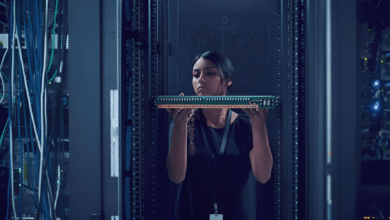
Through the provision of scalable and adaptable solutions for data processing, data storage, and software delivery, cloud computing has completely changed how businesses function. Exploring cloud computing’s future and the trends that will influence this sector in 2023 and beyond is crucial given how quickly technology is developing.
When computer services are delivered online, it is referred to as “cloud computing.” Users can access and use resources including servers, storage, databases, software, and analytics at any time. The IT industry has undergone a transformation thanks to this technology, which has allowed companies to expand their operations, save costs, and boost productivity.
Current Cloud Computing Situation
Currently, cloud computing is a crucial component of many sectors’ businesses. Organizations are using cloud services to improve collaboration, streamline operations, and spur innovation. The market is dominated by large cloud service providers like Amazon Web Services (AWS), Microsoft Azure, and Google Cloud Platform (GCP), who also keep expanding their product lines.
An increase in cloud computing
In the upcoming years, it’s anticipated that cloud computing will continue to expand. Industry reports predict that by 2023, the worldwide cloud computing market will be worth billions of dollars. The increased acceptance of cloud-based solutions, technological improvements, and the rising demand for digital transformation are a few reasons for this expansion.
Future Predictions for Cloud Computing

Increased Adoption of Multi-Cloud Strategies: To fulfill their unique needs, businesses are utilizing multi-cloud strategies that make use of the services of several cloud providers. Greater flexibility, risk reduction from vendor lock-in, and performance optimization are all features of this strategy.
Rise of Edge Computing: Edge computing, which moves processing power closer to the source of the data, will become more prominent. It enables real-time data processing, lowers latency, and supports applications like autonomous vehicles and Internet of Things (IoT) devices that demand low latency and high bandwidth.
Enhanced Security and Privacy Measures: Cloud providers will concentrate on enhancing their security measures as data privacy requirements become stricter. Sensitive information will be protected by encryption, data anonymization, and strong authentication mechanisms.
Integration of AI and ML: Cloud computing and AI/ML technologies will come together to provide organizations with intelligent solutions. Organizations will be able to use the power of machine learning for a variety of purposes thanks to cloud-based AI platforms that enable the seamless integration of AI algorithms into applications.
The Adoption of Serverless Computing: Serverless computing, sometimes referred to as Function-as-a-Service (FaaS), will become widely used. Developers are now free to concentrate on creating and delivering particular functionalities rather than managing the supporting infrastructure thanks to this paradigm change. It gives applications better time-to-market, cost-effectiveness, and scalability.
Cloud computing has a significant deal of potential given the enormous processing capability of quantum computing. Although technology is still in its infancy, the combination of quantum computing and the cloud will open up new avenues for solving difficult optimization issues and cryptography.
projects for Green Cloud Computing: Environmental concerns have sparked the creation of projects for green cloud computing. To reduce their carbon footprint, cloud providers are making investments in renewable energy sources, increasing energy efficiency, and implementing sustainable practices. eco-friendly data centers.
Growth of IoT and Cloud Synergy: As the Internet of Things (IoT) develops, it will produce enormous volumes of data. In order to handle and analyze this data, real-time insights and intelligent decision-making will be made possible thanks in large part to cloud computing. IoT and cloud computing’s synergy will spur innovation across all industries.
Blockchain and Decentralised Cloud Computing: Decentralised cloud computing will benefit from the security and transparency of blockchain technology. Decentralized computing platforms will provide better data privacy, decentralized storage, and increased cyber attack resilience.
Augmented and virtual reality on the cloud will revolutionize fields including gaming, education, healthcare, and manufacturing. Augmented reality (AR) and virtual reality (VR) will be integrated with cloud computing. Immersive experiences will be possible thanks to cloud-based AR/VR technologies.
Containers and microservices are two examples of cloud-native application development techniques that will continue to grow in popularity. These designs enable enterprises to build and deploy applications more quickly and with greater scalability and fault tolerance.
Hybrid Cloud Solutions: Public and private clouds will increasingly be combined to form hybrid cloud solutions. By utilizing the advantages of both public and private cloud environments while keeping control over sensitive data and apps, this strategy gives organizations greater flexibility.
Read More: How to Use Social Media for Brand Awareness 2023
Concerns and Obstacles in Cloud Computing

Although computing has a bright future, there are also issues and obstacles that need to be resolved:
Privacy and security: Protecting the privacy and security of data stored in the cloud is still of utmost importance. To earn users’ trust, cloud companies must establish strict security controls and adhere to legal requirements.
Data Governance and Compliance: In multi-cloud systems, managing data governance and adhering to industry-specific requirements can be challenging. Organizations must devise plans to preserve data integrity and adhere to regulatory standards.
Vendor Lock-in: Relying solely on one cloud provider may lead to vendor lock-in, which would limit flexibility and scalability. Adopting hybrid or multi-cloud techniques can aid in reducing this risk.
Performance and Latency: Relying primarily on cloud services may provide difficulties for applications that need real-time processing and minimal latency. By processing data, edge computing technologies can meet these performance requirements.
Cost management: While computing can reduce expenses, doing so can be difficult. To prevent unforeseen costs, businesses need to monitor and maximize their cloud usage.
Read More: Cloud Computing: A Game-Changer for Small Businesses 2023
Conclusion
Future developments and revolutionary tendencies in cloud computing are anticipated. The industry will change as a result of increased edge computing adoption, improved security measures, and the incorporation of AI and machine learning. Blockchain, augmented reality and virtual reality, serverless computing, quantum computing, sustainability initiatives, cloud-native technologies application development, and hybrid cloud solutions will significantly boost computing innovation and effectiveness.
It’s critical to address the issues and worries surrounding security, data governance, vendor lock-in, performance, and cost management as businesses navigate the future of cloud computing. Organizations can maximize the advantages of computing while minimizing potential risks by proactively implementing strong security measures, adhering to data governance regulations, adopting multi-cloud or hybrid cloud strategies, utilizing edge computing when necessary, and optimizing cloud costs.
FAQs
Cloud computing: What is it?
When computer services are delivered over the internet, on-demand access to resources like servers, storage, databases, and software is made possible.
What advantages can cloud computing offer companies?
Businesses can gain a lot from computing, including scalability, cost-effectiveness, flexibility, greater collaboration, increased data security, and quicker application deployment.
Is using the cloud safe?
When the right security measures are in place, computing can be secured. To protect user data, cloud companies adopt strict security procedures, encryption, and data privacy measures.
Which major trends in cloud computing are there?
The rising use of multi-cloud strategies, the rise of edge computing, improved security measures, incorporation of AI and machine learning, serverless computing, quantum computing, green initiatives, and IoT and cloud synergy are some of the key trends in computing.
How can companies get ready for cloud computing in the future?
By keeping abreast of new trends, reviewing their cloud strategy, adopting multi-cloud or hybrid cloud approaches, putting in place strong security measures, and optimizing cloud expenses to maximize efficiency, businesses may get ready for the future of cloud computing.












4 Comments